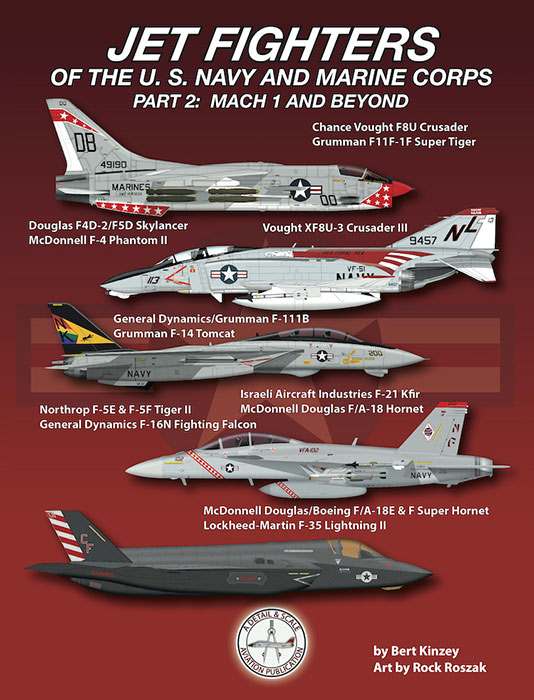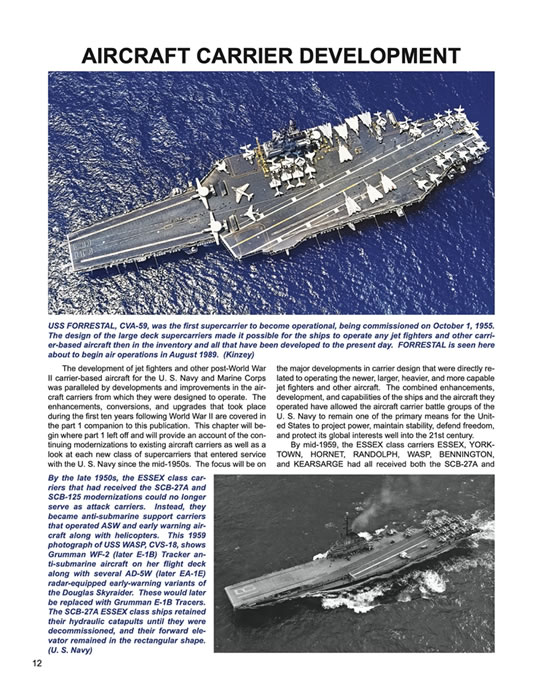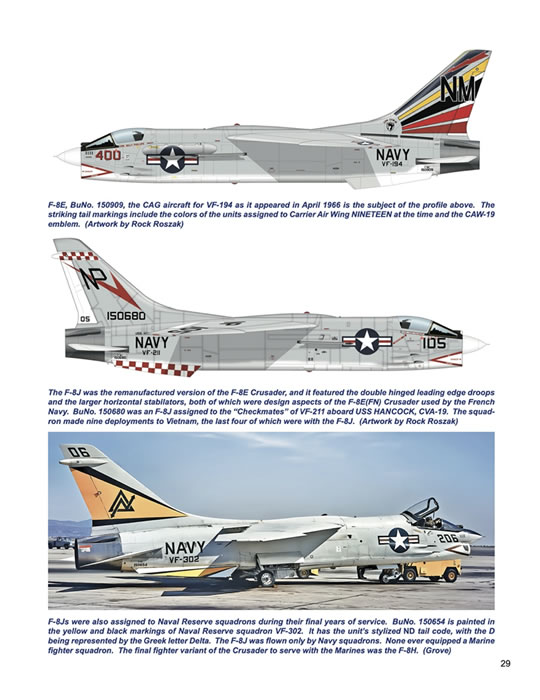Jet Fighters of the US Navy and Marine Corps Part 2: Mach 1 and Beyond

Detail & Scale
S u m m a r y : |
Title and ISBN: |
Jet Fighters of the US Navy and Marine Corps Part 2: Mach 1 and Beyond
Detail & Scale Aviation Publications
by Bert Kinzey, art by Rock Roszak
Detail & Scale Aviation Publication |
Contents & Media: |
113-page book contains 208 photographs (188 in color) and 10 full color aircraft profiles. |
Price: |
Digital Version; $14.99 (USD), Print Version $21.99 (USD)
available online from Detail & Scale Publications |
Review Type: |
First Read. |
Advantages: |
Well written and detailed; high quality photo reproduction; profile artwork |
Disadvantages: |
|
Conclusion: |
While this review is based on the printed version from Amazon there is also a digital version that will allow you to enlarge the photos and get even more use out of it. This is another great reference book by Detail & Scale. |
Reviewed by Floyd S. Werner Jr.

Following up Part 1 of the Jet Fighter series, this volume focuses on the fighters that go faster than the speed of sound. There have been 13 fighters that meet that criterion. Starting with the F8U Crusader to the F-35, including prototypes like the F-111B. Besides these fleet fighters, the adversary aircraft such as the F-16N and F-5E are also covered. This period of fighters included the war fighters of the Cold War.
The book is a paperback book containing 113 pages of with the history, operational use and development of each aircraft. Almost all the photos are in full color, along with some aircraft profiles by Rock Roszak. There are 208 photos with 188 in full color and 10 full color profiles by Rock Roszak.

Detail & Scale are known for their extensive coverage of aircraft and this book is a great overview of these fighters. Not just the fighters are covered. Advancements in aircraft carriers is discussed because as the fighters grew bigger and flew faster they needed bigger ships with different landing systems and powerplants. The carrier development shows from the Essex class of the late 1950s to the modern day Ford nuclear carriers and the new Marine assault ships.
Then the book gets into the fighters, starting with the F8U Crusader, the last gunfighter. The development of this great fighter plane is chronicled. The photo recon birds are shown as well. Historically significant for the role they played in the Cuban Missile Crisis.

The F11F-1F Super Tiger is shown. Although not used in the fleet it is a beautiful airplane. As was the Douglas F5D Skylancer, the successor to the F4D Skyray. This colorful aircraft was used by NASA in some gawdy colors for visibility.
Then the next fleet fighter is the iconic, F-4 Phantom. Used by the Navy and Marines this aircraft came to optimize the Vietnam War. Deploying in that theater in some quite colorful paint schemes. The prototype, through the B, J, N and S are covered. With 40 kills by Navy/Marine F-4s it would become the best air to air fighter the fleet used in Vietnam until the 1980s when the remainder were converted to QF-4 drones.
The XF8U-3 Super Crusader is up next. This fighter was better than the F-4 in the flyoff, however, it was decided that two engines and two pilots were better than one. So this aircraft was relegate to obscurity.
Touted by Robert McNamara as the be all, end all fighter for the Navy and the Air Force, the F—111B was tested. Its variable sweep wings would be an indicator of what was to come next but its heavy weight precluded it from carrier operations.
Tomcat. The word conjures up movie star roles such as ‘Top Gun’ and ‘The Final Countdown’. The Turkey, as it was affectionately known, is an icon in naval aviation history. Flying at the very end of the Vietnam War, at least at the very end with the withdrawal from Saigon, the F-14 had a wide array of armament from which to fly and fight with, including the AIM-54 Phoenix missile system. The Tomcat shot down Libyan fighters in 1981, the first air to air kills since the Vietnam war. They did it again in 1986, again shooting down two Libyan fighters. The Tomcat evolved over time into a Bombcat and photo recon aircraft by adding TARPS pods. The F-14 continued to dominate in the skies of the Mideast, especially in the service of the Iranian Air Force. Eventually replaced by the F/A-18 Hornet, which was actually a smaller and less capable aircraft, the F-14 had held the front line for over 30 years.
The F-5 Freedom Fighter was used by the Navy as an aggressor in its Top Gun program. The paint schemes on these fighters are quite eye catching. They are painted up to mimic potential foreign adversaries. Of course, those that watched ‘Top Gun’ will recognize the MiG-28 version of this aircraft.
Another adversary aircraft is the F-21A Kfir out of Israel. This aircraft is which was designed in Israel is the only adversary aircraft that wasn’t designed and produced by a US company. It also featured some really nice paint scheme.
The replacement adversary aircraft for the F-21 was the F-16 Fighting Falcon. Used by both Marines and Navy, the F-16N, A and B was used to be the simulator for the MiG-23. The Navy procured 22 single seat F-16N and four TF-16Ns. This aircraft, especially without some of the usual equipment, is the fastest F-16 at the time. F-16As and Bs were used once the embargo of Pakistan took place in 2002. These adversaries are quite colorful and change over their lifetime.
The F/A-18 Hornet, or legacy Hornets, replaced the F-14. After losing the fighter contract with the Air Force to the F-16, the F-17 was redesigned as the F/A-18 and proposed to the Navy. The Hornet actually replaced the F-4, A-7 and eventually the F-14. The combat history is included and the operational testing. Besides the role of the fleet fighter, performing both fighter and attack missions, the Hornet also did the photo recon and the aggressor role. It literally became the jack of all trades. This aircraft was used by the Navy’s Blue Angels for the most
Following on the heels of the Hornet came the Super Hornet. Part of that came about because by redesignating it the Navy could just call it an upgrade and use upgrade money. The Super Hornet had very little in common with Legacy Hornets, save the name. It was over 25% bigger and as such none of the systems were interchangeable. The Super Hornet actually brings a solid airframe to do all the missions on a carrier, fighter, bomber, photo recon, refueler, and electronic counter-measures aircraft. This meant that the logistic umbilical was significantly smaller with common parts for the airframe. The Super Hornet has just become THE Navy aircraft.
The newest Navy and Marine Corps fighter is the stealth F-35. This aircraft may be the last of the manned fighters of the Navy. There are three versions and they are all discussed along with plenty of photos of them.
Seeing all these aircraft in overview in full color photos and with profile drawings is inspirational to say the least. Reading about the various deployments, engagements and history is a great way to get backstory for your models. Now if you are looking for the in depth, nuts and bolts photos this book isn’t that kind. It is a great book for the overview and history of each aircraft. Does that mean it doesn’t have some in depth photos? No, of course not. There are cockpit photos and photos of most of the engines used on the covered aircraft. If decal manufacturers just looked through this book they would have some great selling sheets. While this review is based off of the printed version from Amazon there is also a digital version that will allow you to enlarge the photos and get even more use out of it. This is another great reference book by Detail & Scale.
Highly recommended
Thanks to Detail & Scale for the review copy. You can obtain yours on Amazon at
ttps://www.amazon.com/dp/B08KSK6T4X
Review Copyright © 17 February, 2021 by Floyd S. Werner Jr.
Last updated
17 February, 2021
Back to HyperScale Main Page
Back to Reviews Page

|
